The world is constantly changing in a variety of ways. The changes are such that we cannot adequately measure them as it is happening, only when it has happened. No single event has dominance in the changes that we have witnessed in the past century. This post is about how transistors changed the world. Perhaps a more suitable title is how the invention of transistors contributed to the world as we now know it.
If you have ever visited Northern Nigeria, West Africa, you will notice that most of the men, own battery-powered radio sets, appropriately named Transistor Radios. These are portable radio receivers that were manufactured in the 1960s and 1970s in billions. These changed the music and news listening habits of many people back then and continues to do so today in countries where communication is still being developed. Admittedly, these radios may no longer use transistor circuitry, but their physical design remains the same, and the usage has not changed. Old habits, they say, die young.
What are Transistors and How Did they Come About?
Transistors are semiconductor devices that are used to in devices like radios and power systems to switch electronic signals or electric power. The image above shows a basic transistor with three legs. To use transistors for amplification purposes, voltage or current is applied to a pair of the three legs and this applied current or voltage through another pair of terminals.The controlled output power can be higher than the controlling (input) power. The above description is how the transistor can amplify a signal. It is this behaviour of transistors that is applied in transistor radios. However, transistors have another behaviour that enabled them to replace Vacuum Tubes in computers and other electronic devices.
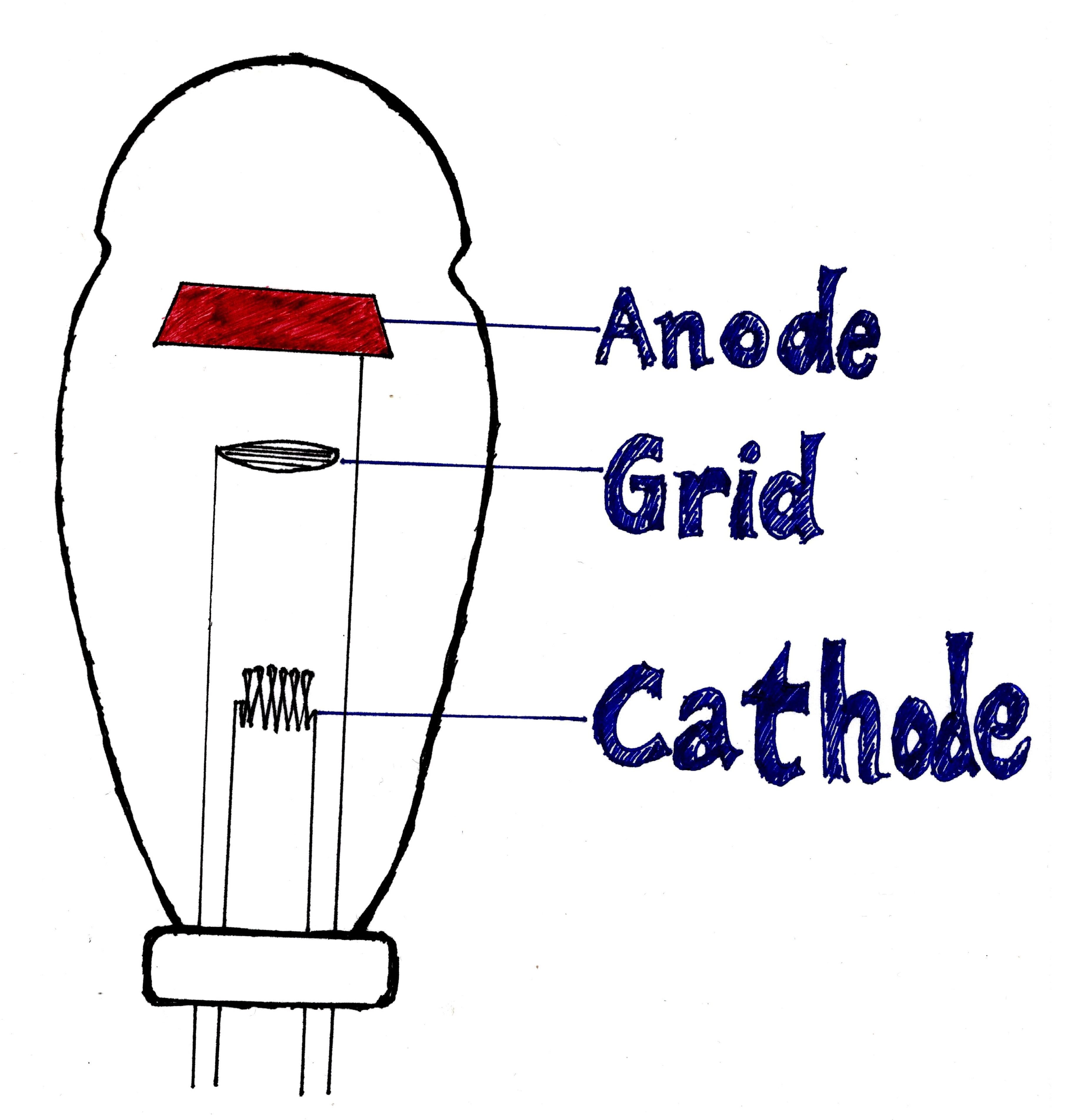
Schematic of A Disconnected Basic Vacuum Tube Showing the Cathode, Anode and the Grid in an Evacuated Glass Bulb
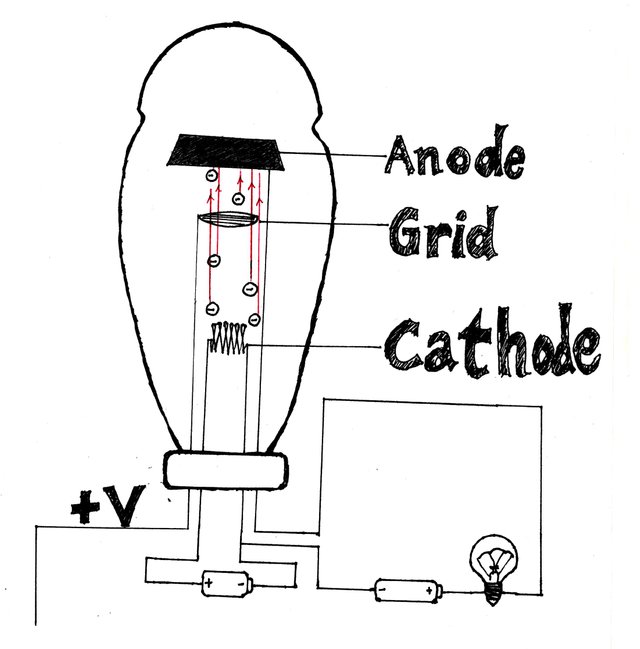)
A Schematic of Vacuum Tubes Showing a Complete Circuit with a Connected Light Bulb and an Applied Positive Voltage
Vacuum Tubes are bulky, evacuated glass bulbs that contain an anode, a cathode and a grid. The simplest form of vacuum tubes is called a diode and includes only two parts: the heated filament (cathode) and an anode plate. This setup allows current to flow just in one direction when the cathode is heated through the application of electricity. Introducing a third component (the grid) affords us some level of control using the vacuum tube.
When electricity is applied to the cathode, it begins to heat up, and electrons start to break free from there and drift freely toward the anode through the grid. The movement of the electrons do not encounter any resistance because the insides of the tube are evacuated of all substances, hence the name vacuum tubes. The mode of operation of the vacuum tube is important for reasons that will become apparent before the end of this post. For the vacuum tube to be used in computing as it was used in those days in the ENIAC, it needed to have a switching function or an ability to allow electrons flow to the anode or not. This is achieved by applying a negative voltage to the grid.
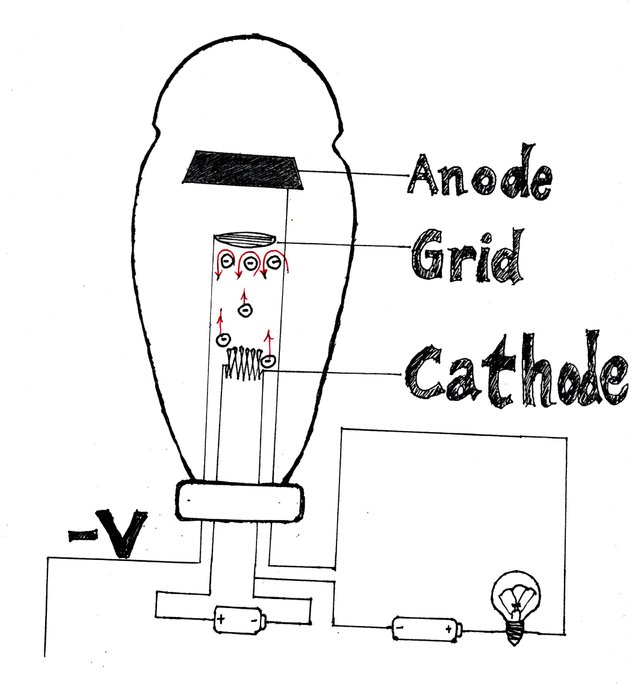)
A Schematic of Vacuum Tubes Showing the Grid Repelling Electrons
The negative voltage applied to the grid makes it negatively charged such that electrons emitted from the cathode would be repelled by the grid and the light bulb connected the circuit will be **OFF**. When the voltage is reversed once again, the circuit is completed, and the light bulb would come **ON**. This is how the vacuum tube achieves its switching functionality that began the advent of binary coding with **1** being represented by **ON** and **0** zero being represented by **OFF**. The first general-purpose computer (the ENIAC) was built with this technology with over 18,000 vacuum tubes. The machine weighed tonnes and filled a room with associated heavy power consumption and problems with regular vacuum tube burnouts and changes. To put this in perspective, your mobile phone has over two billion of these switches in the form of miniaturised transistors made into silicon wafers, and the cell phone can do calculations faster than the ENIAC. An improvement was necessary.
Even though transistors are an integral part of our lives, we seldom see them because they often exist as microchips in most critical applications especially in applications like the microprocessor of computers, mobile phones and other electronic devices. However to understand transistors we have to look at the underlying components and the operation of a single transistor.
The 2N3904 is a common NPN bipolar transistor that is used for amplification in basic circuits. But we are going to explore transistors by examining the chemical makeup of the substances that are used make them. Chief among these materials is Silicon. As we were told from elementary chemistry, the chemical properties of elements on the Periodic Table are determined by the number of electrons in their outermost shell. Silicon has 14 electrons, and there are four of these electrons in the outermost shell. A Silicon atom needs four more electrons to form a stable covalent bond, and it readily finds these among the other silicon atoms in a silicon crystal. This property of silicon is what gives it semiconductor properties, which by the way, are materials that lie between conductors and insulators in the amount of current that they would pass through conduction.
![]()
We can improve the conductivity of silicon by adding impurities to it. One of the impurities that has been found to work is Phosphorus. Phosphorus is next to Silicon on the periodic table and it has five electrons on the outermost shell. When trace amounts of phosphorus are introduced as impurities to a silicon crystal (a process which is called doping). The result of this is that a neighbouring silicon atom can borrow the fifth electron from the phosphorus to make its outermost shell have five electrons. This is not a stable as other silicon atoms keep borrowing the electrons and as it moves around the crystal, it increases the conductivity of the crystal forming an N-Type semiconductor.
![]()
We can subject silicon crystal to doping using Boron this time around. Boron's valence electrons are three. The result of doping with boron is that an electron is pulled from a silicon atom to make the valence electrons of Boron four. This event creates what is referred to as holes which improves conductivity in a P-Type semiconductor.
When a P-type semiconductor is sandwiched between two N-type, an NPN transistor is obtained which as mentioned earlier is one of the most common types of transistors.
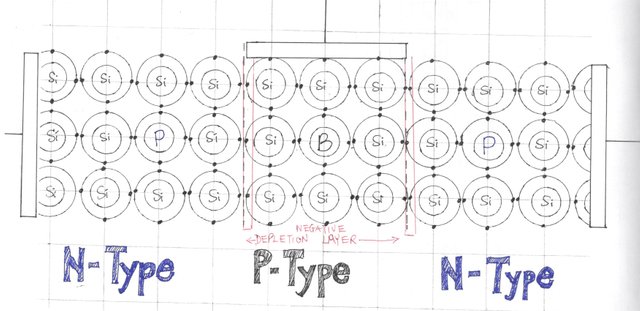
As more electrons move from the N-type portion of the transistor to the P-type portion in an NPN transistor, the atoms in the P-type region become negatively charged, preventing further migration of more electrons to the part. The result of this is that the transistor will not conduct during this time. If a positive voltage is applied to the gate (which is the terminal located around the negative depletion region, the P-type semiconductor atoms will become positively charged and conduct electricity again.
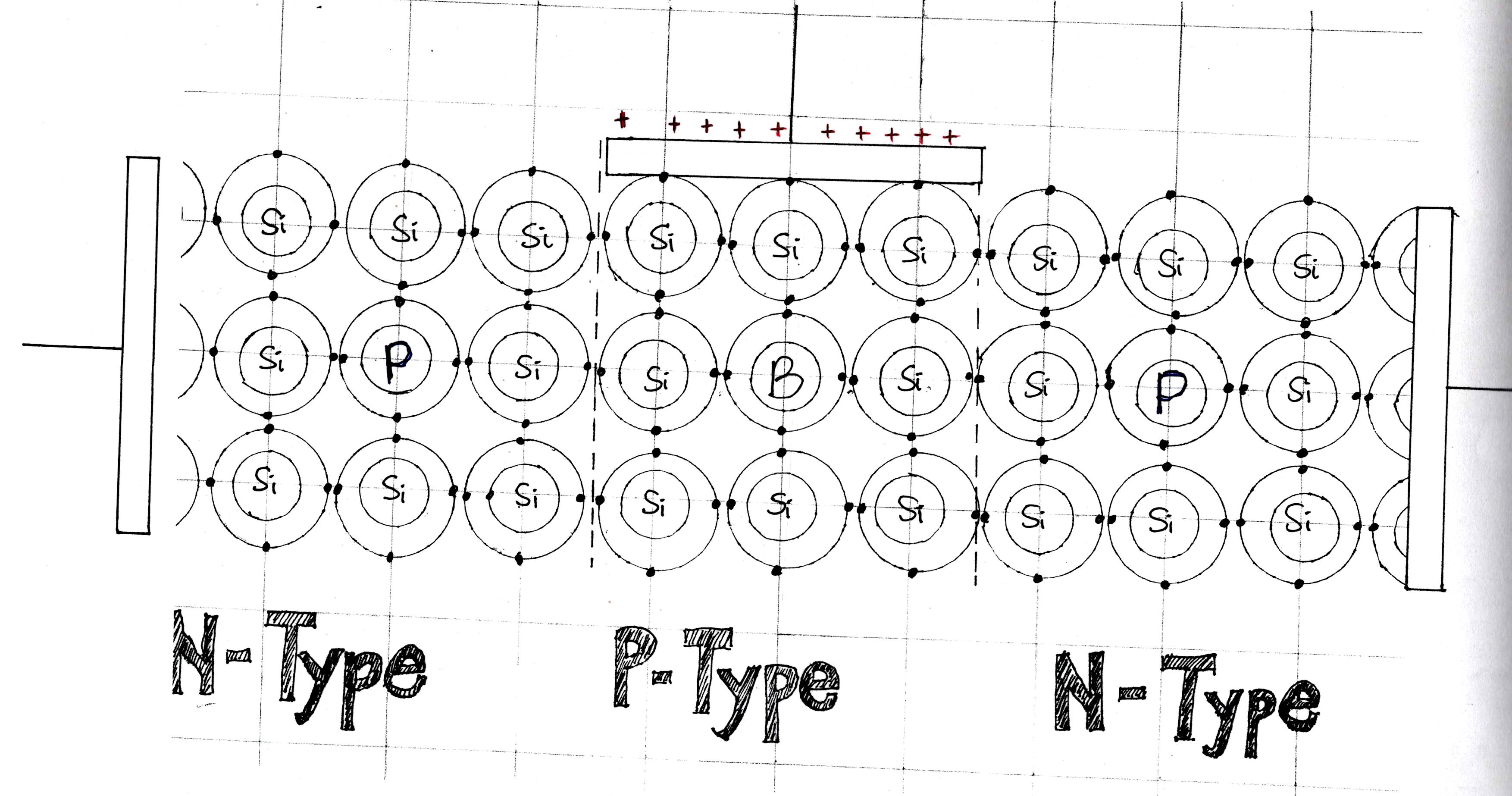
A Schematic of NPN Transistor When a Positive Voltage is Applied at the Gate
You may recall that this is similar to how a vacuum tube functioned as a switch which made both devices suitable for binary coding and laid the groundwork for modern computing. But how does ON and OFF translate to the complex calculations that transistors engender? Yes, it has been said that these ON and OFF represent binary digits (1s and 0s). Now we shall look at a simple calculation that shows the essential functions of transistors in microchips.
In decimal calculations which are calculations involving numbers that we are used to in our daily lives, every number can be formed from just ten numbers:
0, 1, 2, 3, 4, 5, 6, 7, 8, 9.
A number like 12,345 represents ten-thousands, thousands, hundreds, tens and units. In other words, the figure 1 has a value of 10,000, the number 2, has a value of 2,000. 3 is 300, 4 is 40, and 5 is just five.
All of the above would add up to give us 12,345 as follows:
10,000 + 2000 + 300 + 40 + 5
or more appropriately,
1x104 + 2x103 + 3x102 + 4x101+5x100
I don't know if the above is more confusing than the actual binary math that our computers work with but let us find out. In binary, everything is based on the number 2 and there are only two possible values in a binary number: 0 and 1.
The binary number 1111, therefore would be equivalent to:
1x23 + 1x22 + 1x21 + 1x20
which equals 8 + 4 +2 + 1 and is 15
It becomes clear to see that when an extra figure is added in the front, the weight of that digit is double the weight of the previous digit. which means that:
31 = 16 + 15 = 11111
In case the number 16 is confusing to you, we arrived at it by recognizing the number 1 attached in front of 1111 as:
1x24.
Assuming all that is clear, then we can easily deduce that 6 = 0110 and 5 = 0101 in binary. We arrived at this by recognising that using zero as a multiplier 8 and 1 in 8+4+2+1 would yield 6 and use zero as multiplier for 8 and 2 gives us 5.
Now let us add 5 and 6 in binary using our decimal knowledge:
0101
0110
1011
What we have done is to add zero and one when either of the numbers is one. Then when both numbers are one, we do a carry to the next position.
Well, it turns out that there are devices called logic gates which are built with transistors due to their switching abilities. An XOR (pronounced eks-or) [4] logic gate performs add operation just like above while an AND logic gate
[4] logic gate performs add operation just like above while an AND logic gate  [5]performs a carry operation that is needed. When we connect the two together as shown in the next image, we can achieve the addition of 5 and 6 in binary.
[5]performs a carry operation that is needed. When we connect the two together as shown in the next image, we can achieve the addition of 5 and 6 in binary.
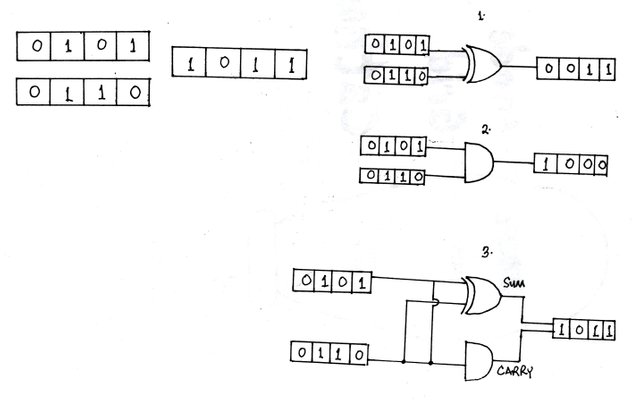
When millions and billions of these are compressed in a microchip, that's when the magic happens as they can do calculations that were thought insoluble just a few decades ago.
This is how transistors changed the world to a connected world.
If you made it to this end, you are either geekier than I am or this post was not as long as I thought it was. Either way, I'd like to thank you for reading.
)

Being A SteemStem Member
Downvoting a post can decrease pending rewards and make it less visible. Common reasons:
Submit
Amazing! Thank you for the support.
Downvoting a post can decrease pending rewards and make it less visible. Common reasons:
Submit
Quite illustrative with the self-explanatory diagrams. You cannot talk about modern electronics and communication system without mentioning semiconductors especially silicon. Silicon in its purest form is known as intrinsic semiconductors, and it has less conductivity as when you compare it with the one which has some level of an impurity introduced in it, the ones with an impurity atom are said to be doped. Doping is the introduction of impurity atom to increase conductivity. Doping is either done by a trivalent element which has outermost shell electron of three that will enter into covalent bonding with the four outermost electrons of the silicon atom. Since the trivalent electron has one less electron to come into covalent bonding with the four valence electron of silicon, it, therefore, contribute a hole which makes the extrinsic silicon to have majority carrier as the hole and hence is called a P-type semiconductor signifying that the majority carrier is positively charged. The same argument goes when a pentavalent atom is used to dope the silicon atom giving rise to an excess electron which is negatively charged .because the majority carrier is now negatively charged electron, it is therefore called n-type semiconductors.
Other semiconductors include Germanium and Gallium Arsenide. I love semiconductor physics, and I appreciate your work and artistry. Kudos.
Downvoting a post can decrease pending rewards and make it less visible. Common reasons:
Submit
This comment is worth all the efforts put into writing this post. Drawing the diagrams took a while and I had to do some research about the little details of semiconductor technology. You nailed everything you said about semiconductors. I wish I understood it this well when I needed to. Thank you so much for your educative comment. You're appreciated.
Downvoting a post can decrease pending rewards and make it less visible. Common reasons:
Submit
In his writings I understand how to change many tools that can change the way we live. Although I do not really understand the tools of electronic devices, hard to read the contents of your post gives me a little understanding of it. Thanks for sharing.
Downvoting a post can decrease pending rewards and make it less visible. Common reasons:
Submit
Thank you so much. I am glad that my writing has contributed to your understanding. That was the intention. Steem on.
Downvoting a post can decrease pending rewards and make it less visible. Common reasons:
Submit
Wow! A very informative article to explain the topic of Transistors, all the information regarding Diodes, Binary Numbers and Logic gates come into play. Upvoted, my friend!
Downvoting a post can decrease pending rewards and make it less visible. Common reasons:
Submit
Yes, combining the different aspects was intentional. In school, these topics are taught differently and people who appreciate big picture view of things struggle to understand some of the concepts and what is the aim for studying them.
It is always good to have you here. I hope things are looking up at your end. If you're on discord, please do say hello to @churchboy, my friend. All the best.
Downvoting a post can decrease pending rewards and make it less visible. Common reasons:
Submit
cool, i just joined steemit today, a graduate of computer science and a web developer by profession. Lets work together sometime...
Downvoting a post can decrease pending rewards and make it less visible. Common reasons:
Submit
This is so nice. I am glad to have you here. You are going to enjoy steemit with so many awesome people gathered in the same place, sharing similar goals. Surely, we shall do some work. Please keep in touch on discord. All the best.
Downvoting a post can decrease pending rewards and make it less visible. Common reasons:
Submit
discord... i registered yesterday and it's just like "complex", what are the first steps to get into d system proper? im elpadjo there too...
Downvoting a post can decrease pending rewards and make it less visible. Common reasons:
Submit
Very informative article & explained the technical stuff in a very user friendly format. Thank you for your sharing @churchboy
I also share technical stuff but in a different field :) I will be glad if you may visit my blog too.
https://steemit.com/bitcoin/@pozzecco/one-bitcoin-two-scenarios-will-bitcoin-be-5000-usd-or-17000-usd-bitcoin-technical-analysis-31-01-2018
Downvoting a post can decrease pending rewards and make it less visible. Common reasons:
Submit
Thank you. I am definitely checking you out. I might learn something there.
Downvoting a post can decrease pending rewards and make it less visible. Common reasons:
Submit